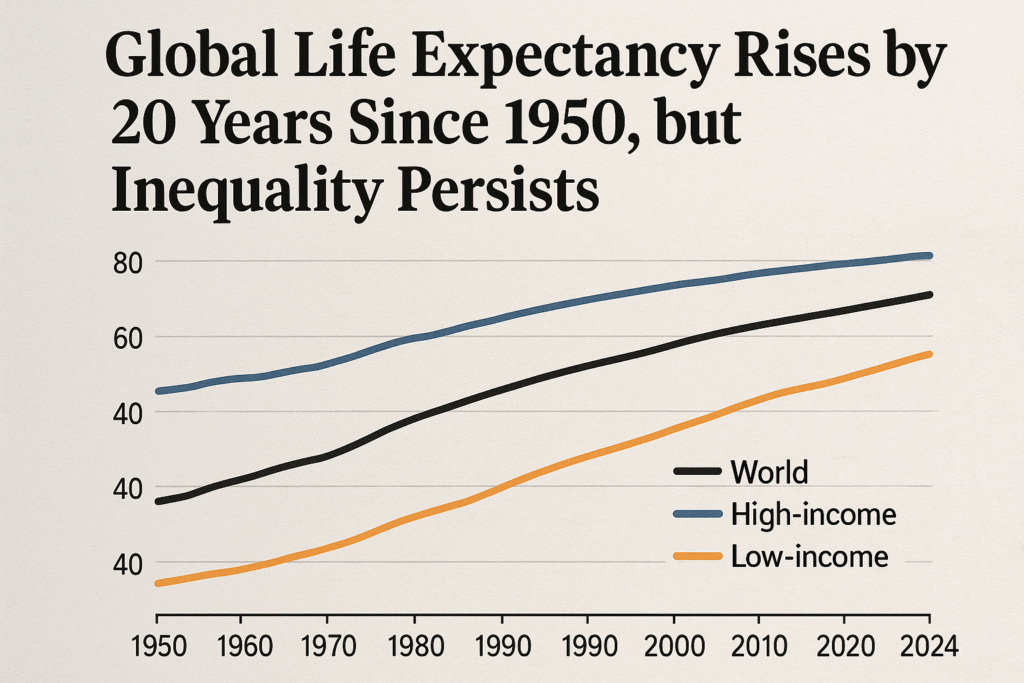By Harshit, SEATTLE, October 14, 2025
Humanity is living longer than ever before — but not everyone is benefiting equally. According to a sweeping new analysis from the University of Washington’s Institute for Health Metrics and Evaluation (IHME), global life expectancy has risen by more than 20 years since 1950, with every one of the 204 countries and territories studied showing improvements in mortality rates. Yet the report warns of an “emerging crisis” among adolescents and young adults, whose death rates are rising in several regions.
Life Expectancy Returns to Pre-Pandemic Levels
Published Sunday in The Lancet, the IHME’s findings reveal that in 2023, life expectancy stood at 76.3 years for women and 71.5 years for men, marking a full recovery from pandemic-era declines.
During the peak of COVID-19, global life expectancy fell sharply for the first time in decades. But by 2023, the coronavirus had dropped from the world’s leading cause of death in 2021 to 20th place.
Heart disease and stroke have once again reclaimed their positions as the top global killers, underscoring a shift toward chronic, noncommunicable diseases as the primary threats to human health.
Infectious Diseases Down, Chronic Conditions Up
Deaths from traditional infectious diseases — such as measles, diarrheal infections, and tuberculosis — have declined dramatically over the past half-century. However, the global health landscape has evolved: noncommunicable diseases (NCDs) now account for roughly two-thirds of all deaths worldwide.
While death rates from heart disease and stroke have dropped since 1990, other chronic conditions have surged. Notably, diabetes, Alzheimer’s disease, and chronic kidney disease have all seen significant increases.
“The rapid growth in the world’s aging population and evolving risk factors have ushered in a new era of global health challenges,” said IHME Director Dr. Christopher Murray. “This data is a wake-up call for governments and health leaders to act strategically to meet these emerging needs.”
Preventable Diseases Still Burden the World
According to the IHME report, half of the global disease burden is preventable — driven by modifiable risk factors such as lifestyle choices and environmental exposures.
Among the 10 leading risk factors are:
- High blood pressure
- Smoking
- High cholesterol
- Diabetes
- Obesity
- Air pollution
- Lead exposure
- Low birthweight
- Short gestation
- Poor diet
Between 2010 and 2023, disease burden due to high body mass index rose by 11%, while the impact of high blood sugar increased by 6%. Mental health challenges also intensified globally, with anxiety and depression ranking among the top contributors to disability and poor health.
A Worrying Trend Among Adolescents and Young Adults
Despite progress in child survival and elderly health, death rates among adolescents and young adults are climbing in some parts of the world.
In high-income North America, deaths among those aged 20 to 39 have surged — largely driven by suicide, drug overdoses, and heavy alcohol use.
In Eastern Europe, the Caribbean, and sub-Saharan Africa, adolescent mortality has risen due to infectious diseases and unintentional injuries.
The data highlights a troubling reversal of decades-long progress in youth health outcomes.
The Role of Inequality in Global Health
The study also reveals massive disparities in global life expectancy.
While people in high-income regions live an average of 83 years, life expectancy in sub-Saharan Africa remains just 62 years — a gap of more than two decades.
Dr. Emmanuela Gakidou, a senior author of the study, warned that recent cuts to international health aid could worsen the divide.
“Decades of work to close the gap in low-income regions are in danger of unraveling,” she said. “These countries rely heavily on global funding for life-saving care, medicines, and vaccines. Without it, the gap will widen even further.”
A Call for Policy Reform
The IHME report urges governments to expand their health priorities, especially for adolescents and young adults. It recommends new investments in mental health, substance abuse prevention, and chronic disease management, as well as renewed global cooperation in funding healthcare infrastructure in low-income nations.
“The health challenges of the next century will not be solved by fighting yesterday’s battles,” said Dr. Murray. “We need a modern, data-driven global health strategy that addresses today’s risks — and tomorrow’s realities.”







